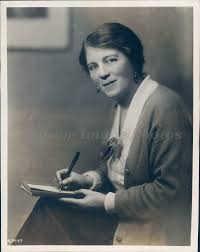
The author, editor and critic Naomi Royde-Smith was a contributor to Time and Tide’s books pages in its very first year, and then more regularly from the mid-1920s. Although her own novels rarely received critical acclaim, she would in later life become a gifted biographer. Her main talent however lay in discovering, and nurturing literary talent in others. She was an early champion of Graham Greene, Aldous Huxley and Rose Macaulay, publishing their early poetry when she was literary editor of the Saturday Westminster Gazette (1912 – 1923).
Naomi Gladwys Royde Smith (no hyphen, at first), was born at home just outside Halifax, Yorkshire, on 30 April 1875, the first of eight children. Her father, Michael Holroyd Smith came from a family of comfortably-off industrialists, making copper wiring to provide materials for telegraph cabling, electric dynamos and fencing: the nuts and bolts of Britain’s industrial expansion. Her mother, Anne, known as Daisy, née Williams was from a Welsh non-conformist family and was a gifted pianist and sparkling wit.
Naomi was educated at home until she was twelve, but was then sent to the North London Collegiate School for Girls, run by Frances Buss, a pioneer in women’s education, and then, after a year’s break, completed her schooling at the Clapham High School for Girls, another beacon in girls’ education, after the family moved to Tooting.
After the collapse of her father’s business, Naomi spent her early twenties teaching, both in London and Switzerland and fending off marriage proposals. In 1903, she obtained a job as assistant to Hulda Friederichs, a rare professional woman journalist, when Friederichs was appointed editor of the new Saturday edition of the Westminster Gazette. Naomi immediately made her mark, starting up the celebrated ‘Problems’ page on the paper, inviting young poets to write in with sonnet and verse responses to literary questions, the prizes for publication up to three guineas. It was on these pages that Rose Macaulay, Rupert Brooke, Graham Greene and others first had their work published and when in 1912 Naomi became literary editor of the Saturday Westminster Gazette she continued encouraging young writers, through her Thursday soirées. She was a great networker and counted as her friends Mary Agnes Hamilton, Theodora Bosanquet and Sylvia Lynd, all of whom would become stalwarts of Time and Tide. She was also, with Rebecca West, on the founding committee of the British version of the Prix Femina-Vie Heureuse Prize, an international literary prize celebrating young authors.
Her Thursday soirées reached their height of cultural influence after the end of the First World War when she and her then great friend Rose Macaulay would jointly host parties attended by writers spanning the generations, from Arnold Bennett and Walter de la Mare, to up and coming young novelists including Storm Jameson and Aldous Huxley. For a while she was influential enough to earn a bitter note in Virginia Woolf’s diary, who described Royde-Smith as her ‘foe’. After the Westminster Gazette folded in 1923, Woolf actively conspired against Royde-Smith becoming literary editor of the Nation and Athenaeum, a post she was in the running for until Woolf’s intervention. It was eventually offered to Woolf’s friend T. S. Eliot. Instead, Royde-Smith was briefly editor of the elite women’s paper The Queen January – September 1924. Her attempts to turn it into a literary journal along the lines of Time and Tide ended in her sacking just nine months into the role.
Royde-Smith wrote book reviews for Time and Tide throughout the interwar years, often reviewing works by friends of hers, ironically commenting once on what was known as ‘log-rolling’. She was also, for a while, chief poetry reviewer.
She would in all write twenty-six novels, starting with her most acclaimed one, The Tortoishell Cat (1925). Despite her massive literary output – she also published more than twenty other works including anthologies, plays and biographies – she spent her final years in penury in a bedsit in Winchester, sustained by a small pension from the Society of Authors, won for her by fellow Time and Tide contributor Eleanor Farjeon.
By Dr Sarah Lonsdale. Dr Lonsdale is a Senior Lecturer in Journalism at City, University of London. She has written further about Naomi Royde-Smith in her recent book, Rebel Women Between the Wars (Manchester University Press, 2020). You can find out more about Royde-Smith’s editorship of The Queen in the 10-minute pre-recorded talk Dr Lonsdale contributed to our Festival of Women Writers and Journalists.
Sources:
Saturday Westminster Gazette
Clay, Catherine, Time and Tide: The feminist and cultural politics of a literary magazine. Edinburgh University Press, 2018.
Benton, Jill, Avenging Muse: Naomi Royde-Smith 1875 – 1964. Pitzer College, 2015
Lonsdale, Sarah, Rebel Women Between the Wars: Fearless Writers and Adventurers. MUP, 2020.